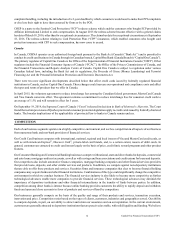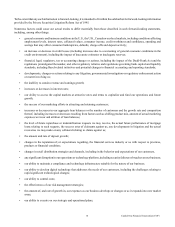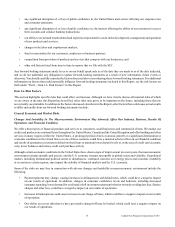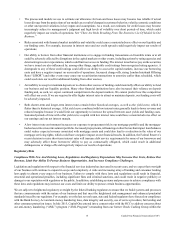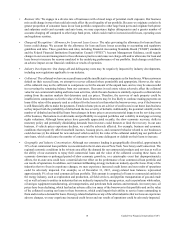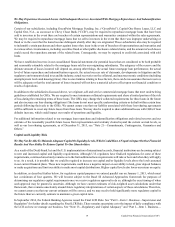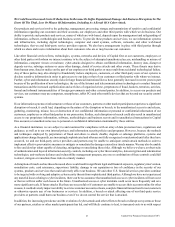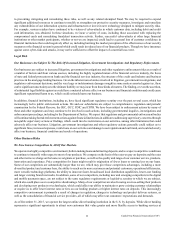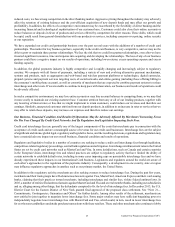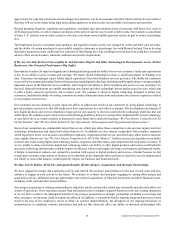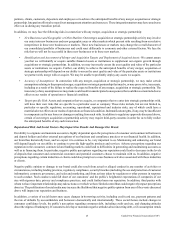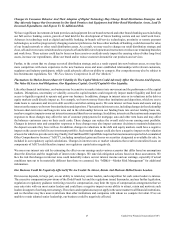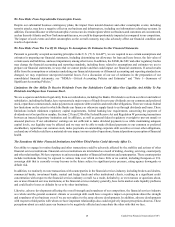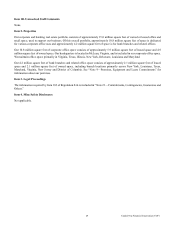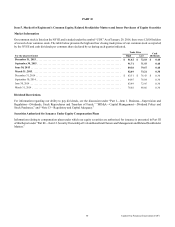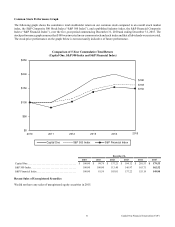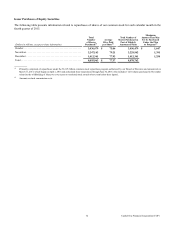Capital One 2015 Annual Report Download - page 41
Download and view the complete annual report
Please find page 41 of the 2015 Capital One annual report below. You can navigate through the pages in the report by either clicking on the pages listed below, or by using the keyword search tool below to find specific information within the annual report.22 Capital One Financial Corporation (COF)
to preventing, mitigating and remediating these risks, as well as any related attempted fraud. We may be required to expend
significant additional resources to continue to modify or strengthen our protective security measures, investigate and remediate
any vulnerabilities of our information systems and infrastructure or invest in new technology designed to mitigate security risks.
For example, various retailers have continued to be victims of cyber-attacks in which customer data, including debit and credit
card information, was obtained. In these situations, we incur a variety of costs, including those associated with replacing the
compromised cards and remediating fraudulent transaction activity. Further, successful cyber-attacks at other large financial
institutions or other market participants, whether or not we are impacted, could lead to a general loss of customer confidence in
financial institutions that could negatively affect us, including harming the market perception of the effectiveness of our security
measures or the financial system in general which could result in reduced use of our financial products. Though we have insurance
against some cyber-risks and attacks, it may not be sufficient to offset the impact of a material loss event.
Legal Risk
Our Businesses Are Subject To The Risk Of Increased Litigation, Government Investigations And Regulatory Enforcement.
Our businesses are subject to increased litigation, government investigations and other regulatory enforcement risks as a result of
a number of factors and from various sources, including the highly regulated nature of the financial services industry, the focus
of state and federal prosecutors on banks and the financial services industry, the structure of the credit card industry and business
practices in the mortgage lending business. Given the inherent uncertainties involved in litigation, government investigations, and
regulatory enforcement decisions, and the very large or indeterminate damages sought in some matters asserted against us, there
can be significant uncertainty as to the ultimate liability we may incur from these kinds of matters. The finding, or even the assertion,
of substantial legal liability against us could have a material adverse effect on our business and financial condition and could cause
significant reputational harm to us, which could seriously harm our business.
In addition, financial institutions, including us, have faced significant regulatory scrutiny over the past several years, which has
increasingly led to public enforcement actions. We and our subsidiaries are subject to comprehensive regulation and periodic
examination by the Federal Reserve, the SEC, OCC, FDIC and CFPB. We have been subject to enforcement actions by many of
these and other regulators and may continue to be involved in such actions, including governmental inquiries, investigations and
enforcement proceedings, including by the Department of Justice. We expect that regulators and governmental enforcement bodies
will continue taking formal enforcement actions against financial institutions in addition to addressing supervisory concerns through
non-public supervisory actions or findings, which could involve restrictions on our activities, among other limitations that could
adversely affect our business. Litigation, government investigations and other regulatory actions generally could subject us to
significant fines, increased expenses, restrictions on our activities and damage to our reputation and our brand, and could adversely
affect our business, financial condition and results of operations.
Other Business Risks
We Face Intense Competition In All Of Our Markets.
We operate in a highly competitive environment, both in making loans and attracting deposits, and we expect competitive conditions
to continue to intensify with respect to most of our products. We compete on the basis of the rates we pay on deposits and the rates
and other terms we charge on the loans we originate or purchase, as well as the quality and range of our customer service, products,
innovation and experience. Price competition for loans might result in origination of fewer loans or earning less on our loans.
Some of our competitors are substantially larger than we are, which may give those competitors advantages, including a more
diversified product and customer base, the ability to reach out to more customers and potential customers, operational efficiencies,
more versatile technology platforms, the ability to innovate faster, broad-based local distribution capabilities, lower-cost funding
and larger existing branch networks. In addition, some of our competitors, including new and emerging competitors in the digital
and mobile payments space, are not subject to the same regulatory requirements or legislative scrutiny to which we are subject,
which also could place us at a competitive disadvantage. Many of our competitors are also focusing on cross-selling their products
and developing new products or technologies, which could affect our ability to maintain or grow existing customer relationships
or require us to offer lower interest rates or fees on our lending products or higher interest rates on deposits. This increasingly
competitive environment is primarily a result of changes in regulation, changes in technology and product delivery systems, as
well as the consolidation of financial service providers, all of which may affect our customers’ expectations and demands.
As of December 31, 2015, we operate the largest online direct banking institution in the U.S. by deposits. While direct banking
represents a significant opportunity to attract new customers that value greater and more flexible access to banking services at


